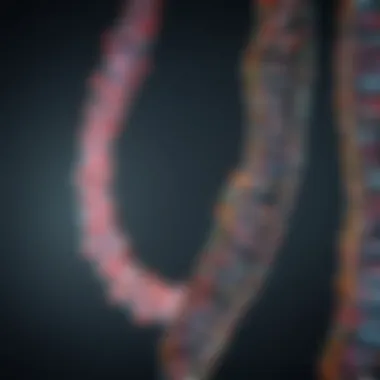RNA Sequencing Process: A Comprehensive Guide


Intro
The field of molecular biology has undergone significant evolution in recent years, primarily driven by technological advancements in sequencing techniques. One technique that stands out in its importance is RNA sequencing, commonly referred to as RNA-seq. This method allows researchers to delve deep into the world of gene expression, unlocking secrets that govern cellular behaviors and interactions.
Unlike the mere amplification of DNA, RNA sequencing captures the transcribed RNA molecules, offering a dynamic portrait of gene expression at any given moment. From understanding diseases to exploring developmental biology, RNA-seq paves the way for robust research and insights.
In this exploration, we will dissect the RNA sequencing process step by step, providing clarity on the methodologies, challenges, and future implications of this pivotal technique.
Foreword to RNA Sequencing
Understanding RNA sequencing is paramount in the realm of molecular biology. It offers a lens through which we can analyze the complexities of gene expression. The significance of RNA sequencing lies not just in its ability to reveal which genes are turned on or off, but also in the nuances it uncovers about the conditions affecting these processes. This technique has propelled the fields of genomics and transcriptomics forward, creating pathways to insights previously thought to be out of reach.
Definition and Significance
At its core, RNA sequencing is a method for analyzing the transcriptome, the full range of messenger RNA (mRNA) molecules expressed by an organism. By capturing a snapshot of RNA in a sample, researchers can decipher the rules of gene expression. This is particularly relevant in studies of diseases like cancer, where altered gene expression can shed light on how tumors develop and progress. Moreover, RNA sequencing allows for quantifying gene expression levels, identifying novel transcripts, and discovering alternative splicing events.
The significance of this process stretches across various fields:
- Disease Research: Understanding the transcriptomic changes that accompany various diseases helps in tailoring treatments.
- Developmental Biology: Observing how gene expression evolves during development can illuminate fundamental biological processes.
- Biotechnology: In agricultural sciences, RNA sequencing aids in the development of crops with desirable traits, enhancing food security.
Historical Context
The journey of RNA sequencing began in the early days of molecular biology. Initially, the study of RNA was limited by the methods available for analysis. However, by the 2000s, the advent of next-generation sequencing technologies revolutionized this field. Before this, traditional methods, such as Northern blotting, were onerous and limited in scope. But with the introduction of sequencing platforms like Illumina and Roche 454, researchers could analyze millions of RNA sequences simultaneously.
Major milestones in the development of RNA sequencing include:
- Discovery of Ribosomal RNA: Understanding its role in protein synthesis laid the foundational knowledge for future RNA studies.
- Creation of cDNA libraries: This was a crucial step allowing for the storage and amplification of RNA sequences.
- Advancements in sequencing technology: The shift from Sanger sequencing to high-throughput methods has significantly increased the scalability and efficiency of RNA sequencing.
Over the years, RNA sequencing has evolved into a powerful tool, paving the way for innovative research and therapeutic approaches. Its history, marked by technological advancements and methodological improvements, serves as a testament to the relentless pursuit of knowledge in the study of life at the molecular level.
"Understanding RNA sequencing not only enhances our grasp of fundamental biology but also drives forward the translation of research into meaningful applications in healthcare and agriculture."
Fundamental Principles of RNA Sequencing
Understanding RNA sequencing starts by appreciating how profoundly it effects the field of molecular biology. At its core, the fundamental principles of RNA sequencing explain not only the mechanics but also the underlying significance of RNA within cellular functions and gene expression. This knowledge lays the groundwork for many applications in disease research, diagnostics, and therapeutics, among others. Grasping these principles is crucial for anyone looking to engage with or deepen their understanding of modern genomics, especially in today's rapidly evolving technological landscape.
Overview of RNA Molecules
RNA, or ribonucleic acid, is often described as the middleman between DNA and the proteins that carry out various functions within cells. Unlike DNA, RNA is usually single-stranded and comes in several forms, each playing distinct roles in genetic information processing. The most recognized types of RNA include messaging RNA (mRNA), transfer RNA (tRNA), and ribosomal RNA (rRNA).
- mRNA serves as the blueprint for protein synthesis, carrying genetic instructions from DNA in the nucleus to ribosomes in the cytoplasm.
- tRNA is responsible for transporting amino acids to ribosomes during protein assembly, ensuring the correct sequence is formed according to the mRNA template.
- rRNA combines with proteins to form ribosomes, the cellular machinery responsible for translating mRNA into a polypeptide chain.
This interplay among different RNA molecules is what allows cells to conduct the complex orchestration of life. Quantifying these RNA molecules through sequencing can reveal a cell's metabolic status or response to environmental changes. It turns out, a mere snapshot of RNA presents a whole story about cellular behavior and functionality.
Mechanism of Transcription
Transcription is the initial step in gene expression and involves copying a specific segment of DNA into RNA. This function is performed by RNA polymerase, an enzyme that recognizes a specific promoter region on the DNA, signaling where the genetic information needs to be transcribed.
- Initiation: The RNA polymerase binds to the promoter, unwinding the DNA strands. This sets the stage for the synthesis of RNA.
- Elongation: As the RNA polymerase moves along the template strand of DNA, it adds nucleotides one by one to form a growing RNA chain. Notably, the RNA strand is synthesized in a 5’ to 3’ direction, complementing the nucleotide sequence of the DNA.
- Termination: Upon reaching a terminator sequence in the DNA, the RNA polymerase detaches, releasing the newly synthesized RNA molecule. This RNA is now a precursor, or pre-mRNA, waiting to undergo further processing steps, including splicing, capping, and polyadenylation, before it can function as mature mRNA.
Transcription serves as a gateway for transforming genetic blueprints into functional proteins, framing both basic biological processes and complex responses to environmental variables.
In summary, the fundamental principles of RNA sequencing reveal how intricately RNA molecules are tied to gene regulation and expression. These mechanisms are not just fascinating; they drive research innovations and therapeutic developments, underscoring the significance of understanding RNA in the contemporary scientific arena.
Stages of RNA Sequencing
Understanding the stages of RNA sequencing is crucial for grasping the complexities of this powerful technique. Each stage plays a pivotal role, ensuring that the final results are both accurate and interpretable. When conducting RNA sequencing, there’s a systematic flow from sample collection to data analysis. This structured process not only underscores the integrity of the results but also allows researchers to build upon previous work without reinventing the wheel. Moreover, with the growing significance of RNA-seq in diverse fields like genomics, therapeutic development, and disease diagnostics, a solid understanding of each stage can elevate both research efficacy and discovery speed.


Sample Collection and Preparation
Selection of Biological Samples
The process begins with choosing the right biological samples. The selection of appropriate specimens is a defining factor in the success of RNA sequencing. Tissue specificity is paramount. For example, utilizing liver tissue for a study on hepatic metabolism provides insight unattainable through skin or muscle samples. This nuanced choice ensures the relevance and precision of the findings, making it a valuable focus for discussions in this article.
Additionally, the stability of selected samples during handling is critical. Using fresh samples or preserving them immediately after collection keeps RNA from degrading, safeguarding the integrity needed for accurate sequencing results. While various sources can be scrutinized, choosing well-preserved tissues can minimize variability in RNA extraction and decrease downstream analysis complications.
RNA Extraction Techniques
Detailed attention turns to RNA extraction techniques. Different methods, such as TRIzol extraction or column-based kits, illustrate the diversity in approaches, each with unique strengths. The key characteristic of these methods lies in their efficiency and yield of high-quality RNA. For instance, TRIzol is known for its ability to provide high-purity RNA, which is essential for downstream applications.
Yet, while TRIzol is effective, it can sometimes lead to co-extraction of other molecules, possibly impacting sequencing quality. On the other hand, column-based extraction methods offer convenience and specificity, although they may produce lesser yields. Balancing these factors can mean the difference between a successful sequencing run and one fraught with complications, making it an essential point of examination for this article.
Quality Control of RNA
Assessing RNA Integrity
Following extraction, it’s critical to evaluate RNA integrity. RNA degradation can occur during sampling or extraction, leading to misleading results. High-quality RNA is characterized by an intact structure that is essential for effective translation into cDNA during sequencing.
Assessing integrity usually involves techniques like gel electrophoresis or using a Bioanalyzer. The RIN (RNA Integrity Number) provides a clear metric for RNA quality. A RIN score close to ten suggests pristine RNA, while scores near two indicate significant degradation, which can skew data analysis. Therefore, careful evaluation at this stage is foundational for the entire sequencing project’s reliability and success.
Quantification Methods
Another aspect of quality control is quantification methods. Accurately determining the concentration and purity of RNA not only aids in planning subsequent experiments but also ensures adequate sample input for sequencing. Techniques such as spectrophotometry or fluorometric assays provide reliable quantification, essential for reproducibility.
The uniqueness of modern quantification methods lies in their ability to distinguish between different RNA species, which is particularly useful when studying complex tissues. On one hand, while spectrophotometry is quick and easy, it doesn't give detailed insight into sample purity—using a fluorometer, however, can provide a fuller picture but at a greater cost and time investment. Weighing these options is fundamental in standardizing experimental workflows and ensuring robust data.
Library Preparation
Fragmentation of RNA
The next step involves fragmenting RNA, which is crucial for creating libraries. RNA fragmentation increases the efficiency of sequencing by reducing the size of RNA molecules so they can be effectively processed by sequencers. This process can be conducted chemically or enzymatically, and each method offers distinct advantages.
For instance, enzymatic fragmentation maintains a more uniform size distribution compared to chemical methods, which can lead to biased representation of RNA in the library. Additionally, the capability to control fragment size during library prep can impact the breadth of transcript coverage achieved—getting this right is imperative for comprehensive analysis throughout the sequencer's capabilities.
cDNA Synthesis
Next, cDNA synthesis transforms RNA into complementary DNA, which serves as the template for sequencing. This reverse transcription process is usually accompanied by a high degree of fidelity, crucial for maintaining representation of the original RNA. The uniqueness of this step is in the necessity for achieving a balance; too much enzyme can lead to amplification bias.
Following this synthesis, cDNA must also be purified to ensure that any residual RNA doesn’t contaminate sequencing. This careful consideration of efficiency and purity during cDNA synthesis becomes a key focus area for maintaining data integrity.
Adapter Ligation
The final note in library preparation is adapter ligation. Ligating adapters to the cDNA fragments is necessary for enabling sequencing. These adapters carry sequencing primers and barcodes crucial for multiplexing samples. The effectiveness of attaching these sequences reinforces the efficiency of the sequencing goal itself.
However, it's important to be cautious. Improper ligation can result in loss of reads or bias in data interpretation. Attention to detail in this stage is paramount, making adapter ligation a cornerstone aspect of library preparation.
Sequencing Techniques
Next-Generation Sequencing (NGS)
At this juncture, it’s vital to discuss Next-Generation Sequencing (NGS). This technology has revolutionized the field with its high throughput, allowing millions of sequences to be generated simultaneously. The scalability of NGS holds considerable benefits for researchers, permitting extensive genomic analyses in a fraction of the time traditional methods took.
However, NGS also introduces complexity. Data generated can be voluminous, requiring robust bioinformatics tools for interpretation. Moreover, technique variability can influence the accuracy of sequence alignment and data quality. Proper training in utilizing this technology is thus critical for enhancing research outcomes.
Single-Cell RNA Sequencing
Lastly, Single-Cell RNA Sequencing presents an exciting advancement, allowing researchers to explore gene expression at the individual cell level. This precision is groundbreaking for understanding heterogeneity within tissues and dissecting cell-specific functions.


But this method also demands meticulous handling and sophisticated analysis pipelines due to the high variability that comes from working with single cells. Ensuring reliability in results while enjoying the rich detail such a method offers can be a double-edged sword.
Understanding these stages empowers researchers to design more rigorous studies, paving the way for breakthroughs in science and medicine.
Data Analysis in RNA Sequencing
In the realm of RNA sequencing, data analysis stands as a critical junction where raw information is transformed into meaningful biological insights. Without proper data analysis, the work upstream — from sample collection to sequencing — may as well be an elaborate exercise in futility. The complexities inherent in RNA sequences and the sheer volume of data generated demand a myriad of approaches, tools, and considerations that make this stage one of the most significant parts of the RNA sequencing process.
Bioinformatics Tools and Software
Analyzing RNA sequencing data cannot be achieved without leveraging bioinformatics tools and software. These resources are the heavy lifters in data analysis. Some of the most widely used tools in RNA-seq analysis include:
- TopHat and Cufflinks: These tools are pivotal when it comes to aligning RNA-seq reads to reference genomes and subsequently quantifying gene expression levels.
- HISAT2: This tool offers fast and efficient alignment of sequencing reads, especially useful for managing large datasets.
- DESeq2 and edgeR: These software packages are critical for differential expression analysis, allowing researchers to identify significant changes in gene expression between samples.
The landscape of software tools is continually evolving, responding to the unique challenges that RNA sequencing poses. The choice of tool often hinges on the specific research question at hand and the nature of the data being analyzed.
Alignment and Mapping Strategies
Mapping and alignment strategies take center stage in ensuring that raw sequencing reads are correctly positioned in relation to a reference genome. It's akin to putting together a massive puzzle where each piece is a sequence of nucleotides. Efficient mapping is essential in determining how RNA molecules are expressed.
Different algorithms exist for this purpose, some of which include:
- Genome Alignment: This is when reads are aligned to a reference genome. Tools like Bowtie or BWA are commonly employed here, allowing for high-speed alignment while handling multiple sequence types.
- Transcriptome Alignment: Here, reads are aligned to a set of annotated transcripts. Tools such as STAR are valuable in this regard, especially for aligning junction reads typical of spliced mRNA.
- Novel Transcript Discovery: When the aim is to discover new transcripts, tools like StringTie can be particularly useful. They allow researchers to identify and quantify novel RNAs within a sample.
The mapping and alignment phase is not merely a logistical task; it is the foundation upon which all subsequent analysis rests. Missing this step can result in inaccurate interpretations.
Quantification of Gene Expression
Once reads are aligned, the subsequent step focuses on quantifying gene expression. This involves determining the abundance of mRNA transcripts, providing insights into gene activity within the cells under study. Numerous methodologies and metrics play a role in this quantification:
- Raw Count Data: This is where the number of reads aligned to a gene is counted. While straightforward, this method may not adjust for variations in library size.
- FPKM and TPM: These are normalization techniques that correct for differences in both read length and sample sequencing depth. This adjustment is crucial for enabling fair comparisons across genes and samples.
- Normalized Counts can be used to further balance the data for downstream statistical analysis, making sure that variability does not skew results.
This quantification process provides a roadmap for researchers, illustrating which genes are active, their expression levels, and how these may vary across different conditions or treatments. By piecing together this data, scientists can better understand the underlying biological processes at play, paving the path for hypothesis generation and experimental follow-up.
Applications of RNA Sequencing
The far-reaching implications of RNA sequencing stretch across various domains in biology and medicine, making it a central technique in understanding the genetic underpinnings of life. By facilitating a comprehensive examination of gene expression, RNA sequencing illuminates pathways of diseases, supports drug discovery, and enhances our grasp of various organisms in research settings. With its ability to provide precise and nuanced insights, this technique is reshaping the landscape of genomic studies.
Disease Research and Diagnosis
The role of RNA sequencing in disease research and diagnostics cannot be overstated. By analyzing RNA profiles, researchers can identify gene expression changes associated with specific diseases, whether they be cancers, neurological disorders, or infectious diseases. This capability paves the way for precision medicine, as clinicians can tailor treatments based on the understanding of an individual’s unique genetic expression patterns.
For instance, cancer research has greatly benefited from this approach. RNA sequencing can distinguish between different cancer subtypes, leading to more accurate diagnoses and prognosis. In many cases, the identification of specific gene fusions or mutations through RNA analysis has directly influenced treatment protocols, enabling oncologists to select targeted therapies that are more likely to be effective.
"The power of RNA sequencing lies in its ability to reveal subtle differences in gene expression that can have profound implications for treatment outcomes."
Drug Development
In the realm of drug development, RNA sequencing offers significant advantages. Traditionally, drug discovery has involved a lengthy, trial-and-error process. However, with detailed gene expression data provided by RNA sequencing, scientists are better equipped to identify biomarkers that predict response to various drugs. This not only expedites the discovery of new therapeutics but also reduces costs significantly.
Moreover, during the drug development phase, RNA sequencing can help assess drug mechanisms of action. By evaluating how a drug influences gene expression profiles, researchers can better understand its efficacy and safety. Studies that showcase the differential expression of genes in response to a treatment can highlight potential side effects, thereby steering drug development in a safer, more informed direction.
Model Organisms in RNA-seq Studies
Utilizing model organisms such as zebrafish, fruit flies, and mice has been essential in RNA sequencing studies. These organisms provide invaluable insights into fundamental biological processes that translate into human health. By observing how gene expression varies in response to environmental changes or genetic modifications, scientists can glean information applicable across species.
The use of model organisms allows for the translation of findings in a controlled setting, providing a foundation for understanding complex systems. For example, studies in Drosophila have led to discoveries regarding gene regulation that are relevant to human developmental diseases.
- Benefits of using model organisms in RNA sequencing include:


- Controlled Environments: Allows manipulation of variables to study gene function more closely.
- Cost-Effectiveness: Easier and less expensive to maintain compared to larger mammals.
- Rapid Breeding: Quick generation times speed up experimental procedures.
In summary, the applications of RNA sequencing reach far beyond mere data collection; they are integral to advancing our understanding of health and disease. Engaging with this technology provides an opportunity for researchers and clinicians to push boundaries, exploring uncharted territories in genetics and therapeutics.
Challenges and Limitations
RNA sequencing, though revolutionary, is not without its hurdles. Addressing challenges and limitations is paramount to understanding the overall context of RNA sequencing. These obstacles can arise from technical processes, biological factors, and interpretative intricacies that affect the reliability and application of RNA-seq data.
The technical realm often presents its own challenges. Variability in sequencing can stem from a multitude of sources. For instance, differing sample quality, inconsistencies in library preparation methods, and fluctuations in sequencing depth can all contribute to skewed results. Moreover, the choice of sequencing platform—whether using Illumina, Oxford Nanopore, or others—can also impact the quality of the data obtained. Mistakes can happen, even in the laboratory; thus, ensuring controlled conditions during sample preparation is crucial.
Technical and Biological Variability
Variability, both technical and biological, is a significant consideration in RNA sequencing. Technical variability can occur during each phase of the RNA sequencing process. From the initial collection of biological samples to the final analysis, tiny errors can cascade into major discrepancies in results. A common trait of RNA is its fragility; it doesn't take much to degrade these molecules, which can happen easily with improper handling or storage conditions.
On the biological side, differences in gene expression between samples can seriously complicate data interpretation. For example, when studying different cell types, inherent variability in RNA levels leads to differing baseline expressions. One could find themselves in a situation where the same gene shows variable expression patterns simply because of the biological context in where it is sampled.
Moreover, technical variability can arise from equipment inconsistency or different reagent batches. All these factors can hamper the accuracy of results gathered from RNA-seq and, consequently, the reliability of downstream analyses and interpretations. This highlights the need for rigorous quality control methods, ensuring that every step of the process is closely monitored.
Data Interpretation Issues
As we gather data through RNA sequencing, interpreting that data correctly is no small task. This can be a minefield; even seasoned professionals can find themselves grappling with various biases and assumptions. An initial issue arises from the complexity of the data. RNA-seq generates massive datasets that provide insights into the transcriptomic landscape, but analyzing these requires specialized bioinformatics skills and software.
Alignment inaccuracies can lead to misrepresentation of gene expression levels. If reads are not mapped accurately to the reference genome, the results may yield spurious conclusions. Furthermore, differential expression analysis can be fraught with pitfalls. Common challenges include controlling for multiple testing and establishing appropriate thresholds for significance, which, if handled poorly, can lead to false positives or negatives.
In the realm of RNA sequencing, it is important to differentiate between biological significance and statistical significance. Occasionally, a change in expression might appear significant according to statistical tests but does not hold biological relevance. Thus, the effect size should always be considered alongside statistical metrics.
In summary, while RNA sequencing unlocks a treasure trove of information about gene expression, challenges related to technical and biological variability, as well as intricacies in data interpretation, require thoughtful consideration. Continuous advancements in both technology and methods aim to ameliorate these obstacles, but keeping these limitations in mind ensures a more accurate application of RNA sequencing findings in research.
Future Directions in RNA Sequencing
As the realm of molecular biology progresses, the future of RNA sequencing is a topic well worth exploring. Not only does it hold immense potential for innovative research, but it also shapes how we understand biological processes at a fundamental level. The importance of this segment lies in its capacity to bridge gaps in our current understanding while spotlighting emerging technologies and methodologies that could pave the way for breakthroughs in various scientific fields.
Advancements in Sequencing Technologies
The technical landscape of RNA sequencing has witnessed rapid advancements over the past several years. New sequencing technologies are changing the field faster than a speeding bullet. For instance, improvements in sequencing throughput and accuracy empower researchers to delve deeper into transcriptomic analyses without breaking the bank of time or resources.
Among these newer technologies, long-read sequencing platforms, such as Pacific Biosciences and Oxford Nanopore, allow scientists to attain a more comprehensive picture of RNA molecules. These technologies are beneficial in tackling issues such as complex splicing events and structural variation detection in genetic sequences, challenges that short-read sequencing struggles to address effectively. Here are some key benefits these advancements bring:
- Increased Resolution: Longer reads mean more robust data, which leads to more accurate transcripts assembly and gene expression profiling.
- Cost-Effectiveness: Reduced costs per base sequenced, making RNA sequencing more accessible to a wider range of researchers.
- Time Efficiency: Faster turnaround times for obtaining data, enhancing the speed at which research can progress.
This shift toward rapid and cost-effective sequencing has profound implications in fields like oncology, where understanding tumor RNA can influence treatment strategies.
Integrative Genomics Approaches
In a world where no single technique holds all the answers, integrative genomics stands out as a strategic path forward in RNA sequencing. These approaches combine diverse data types, enriching the analysis of RNA and providing a more holistic view of genomic information.
Engaging with integrative methodologies unites various data, such as proteomic and metabolomic information, offering deeper insights into biological processes. Consider these critical aspects of integrative genomics:
- Cross-Study Comparisons: By incorporating data from various biological studies or experiments, researchers can identify patterns that may not be visible when analyzing data in isolation.
- Enhanced Predictability: Utilizing machine learning algorithms to integrate datasets often leads to models that can predict gene function or interactions with greater accuracy.
- Broader Functional Insights: Data integration extends the analytical capabilities beyond RNA sequences alone, shedding light on how RNA influences protein synthesis, disease mechanisms, and more.
The evolution of RNA sequencing stands not only as a testament to the progress in molecular biology but also as an invitation to explore the uncharted territories of gene regulation and cellular mechanisms.
Finale
The conclusion of our exploration of RNA sequencing unfolds as a crucial segment in understanding how this method has become a cornerstone in molecular biology. A strong grasp of RNA sequencing not only aids comprehension of gene expression but also enhances our ability to apply this knowledge in a manner that is aligned with current technological advancements and scientific inquiry. In encapsulating the journey through the various stages of RNA sequencing, from sample preparation to data analysis, we must appreciate how each element builds on the previous one to produce reliable results.
Summary of Key Points
- Fundamentals and Techniques: The journey begins with the basic principles of RNA, shedding light on how transcripts are produced and manipulated through various techniques like cDNA synthesis and adapter ligation.
- Application Spectrum: The significance of RNA sequencing resonates through its applications in disease research, drug development, and model organism studies, demonstrating its versatility and impact in the field.
- Technical Challenges: Throughout the process, understanding the hurdles such as technical variability and difficulties in data interpretation reveals the complexity and meticulous nature of the work involved.
- Future Directions: As we look to the future, advancements in sequencing technology and integrative genomic approaches hold promise for enhancing the efficacy and scope of RNA sequencing.
Implications for Future Research
The implications of RNA sequencing stretch far and wide, paving the way for new hypotheses and research endeavors. It offers an opportunity to probe deeper into the functional aspects of genes, potentially revealing not only their roles in health but also the intricacies of disease mechanisms. As sequencing technology continues to improve, the barrier to entry lowers, encouraging a broader range of researchers, including those from less resource-rich institutions, to engage in this area of study.
Moreover, the integration with other omics data, such as genomics and proteomics, will likely facilitate a more holistic view of biological systems. This integrative perspective may lead to the discovery of novel biomarkers and therapeutic targets, propelling advancements in personalized medicine. Furthermore, as ethical considerations regarding genetic data continuously evolve, ongoing dialogue and research in RNA sequencing must take these factors into account, ensuring responsible use of technology in line with societal values.



